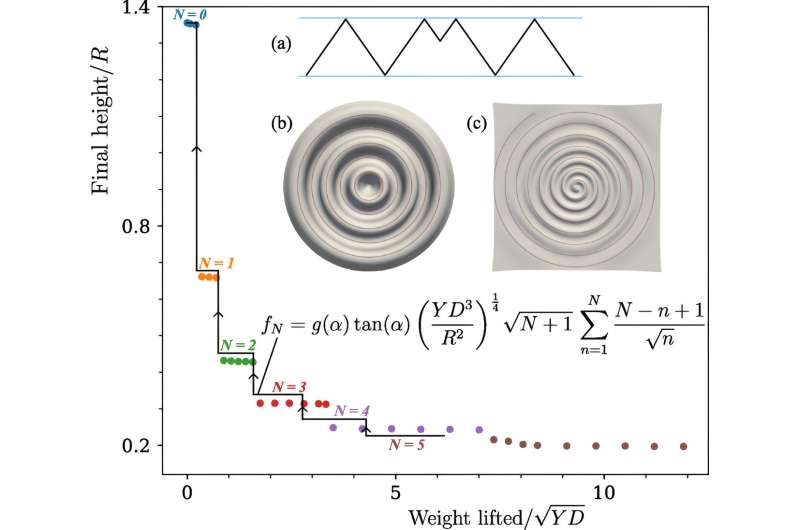This article has been reviewed according to Science X's editorial process and policies. Editors have highlighted the following attributes while ensuring the content's credibility:
fact-checked
peer-reviewed publication
trusted source
proofread
Morphing cones under compression: New research uncovers surprises for soft robotic actuators

Cambridge engineers investigating the load-bearing capacity of conical shells, made from soft materials, have discovered performance-limiting weaknesses that could have implications for soft robotics—affecting the ability of morphing cones to perform fundamental mechanical tasks.
In soft robotics, components are designed to be deformable, squishable and flexible, and often use soft elements, mechanisms, machines and actuators—devices that convert energy into mechanical force—as building blocks to perform mechanical tasks. Examples of such building blocks include pieces of soft material that can grab, pull, push, pump, twist etc.
New research, led by the University of Cambridge, has calculated, for the first time, the strength of conical liquid crystal elastomer (LCE) shells. LCE is a lightweight shape-morphing material suitable for use in soft robotics.
Using a combination of theory, numerics and experiments, the researchers from Cambridge's Department of Engineering and the University of Colorado investigated the lifting, loading and buckling of these thin, morphing LCE films that can lift thousands of times their own weight. Their findings are reported in the journal Physical Review Letters, accompanied by a synopsis in Physics Magazine.
Soft elements for use in soft robotics are often constructed from thin sheets of soft material, so their mechanical actions can be based on pure bending or stretching of the material. The former is weak; the latter is strong, as exemplified by a flat LCE sheet morphing into a cone and lifting a huge weight in the process.
Daniel Duffy, Ph.D. student in the Department of Engineering, University of Cambridge, and co-author of the study, said, "Our work is the first to calculate and understand just how strong a thin-walled cone is. That is, of course, important for designers of soft robots that might utilize shape morphing cones as powerful actuators."
"However, our findings expose a weakness in the strength of these thin cones, which when compressed, deform predominantly in an outer boundary layer. This then instigates buckling at much smaller loads than what has been previously predicted."
He added, "More broadly, our work reveals some key underlying principles that we expect to generalize far beyond cones. We have discovered that free unclamped edges can vastly weaken thin structures in a surprising manner, and this can impact many mechanisms other than morphing cones, including structures that are not anything to do with soft robotics."
More information: Daniel Duffy et al, Lifting, Loading, and Buckling in Conical Shells, Physical Review Letters (2023). DOI: 10.1103/PhysRevLett.131.148202


















